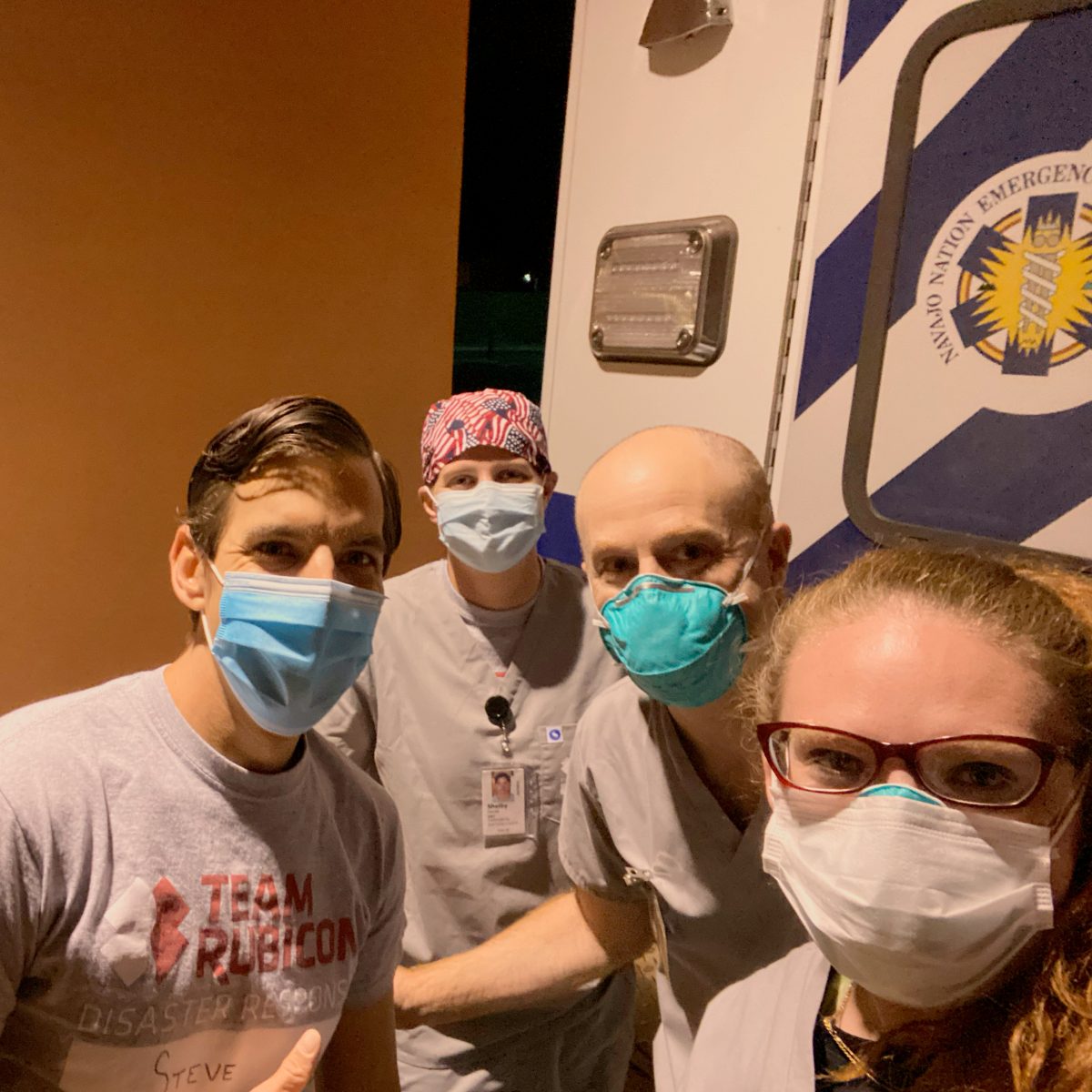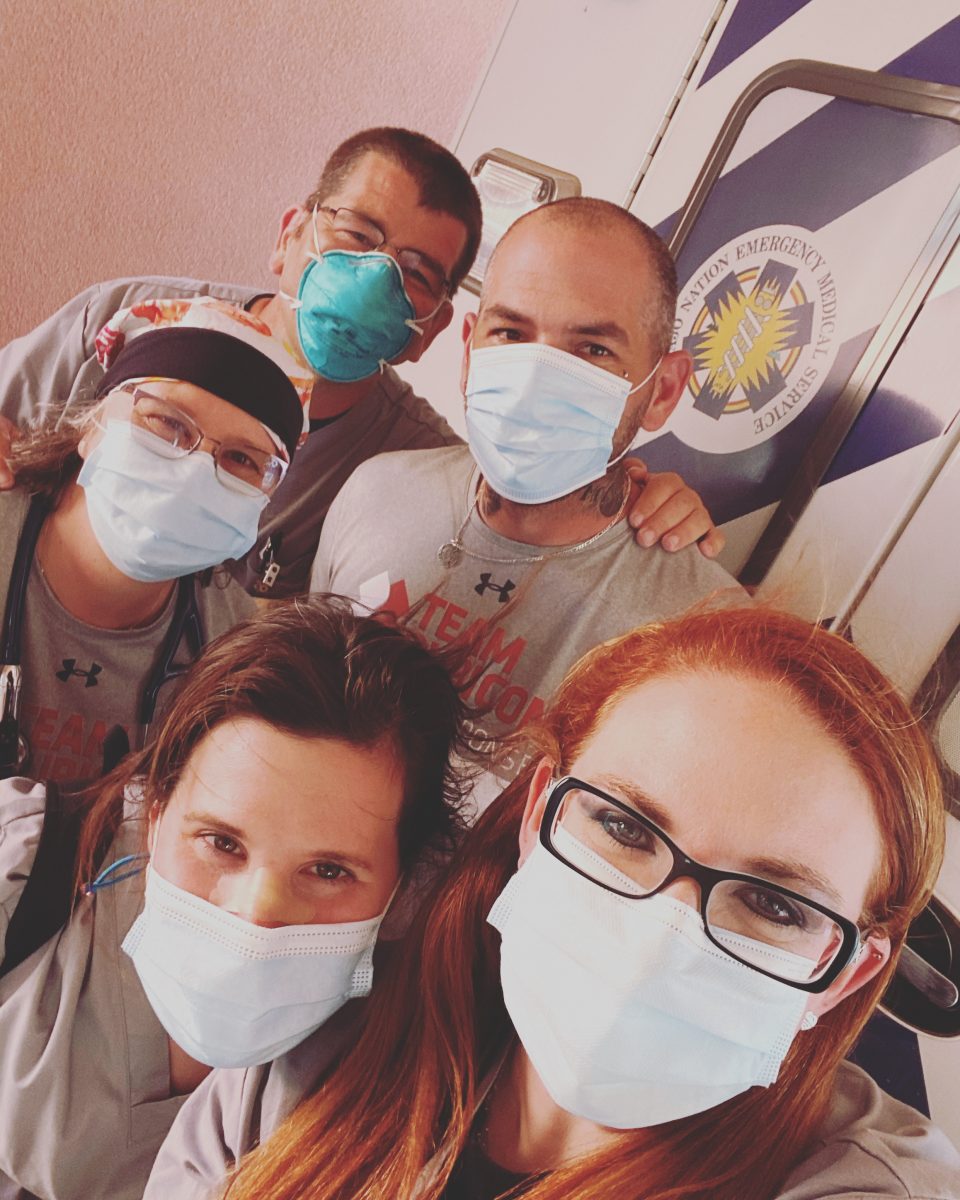The 91-Day Greyshirt
How I went from sign-up to the Navajo Nation’s longest-serving volunteer in just three months.
We all have our own Team Rubicon journey. Mine goes from thinking I didn’t belong to becoming a comms lead in a matter of months.
I grew up wanting to serve in the military. My father was a Marine, and I was still little when he was killed while serving. I had planned to follow his path and join the military too—I even had a date set with the recruiter—but the week before we were to meet I found out I was pregnant. Serving in the military just wasn’t in the cards for me.
Instead, my career path turned to another kind of service—nursing. Still, I have always been drawn to organizations with a veteran-focused mission, and Team Rubicon felt like a great organization to be a part of. But, I quickly moved on because I thought it was only for veterans. I later found out that wasn’t the case.
Fast forward to March of this year, when cities and states started to shut down due to the coronavirus in the U.S. At the time, I was volunteering as a Registered Nurse for the local health department in Phoenix and was doing some work related to COVID-19. Still, it was not on the front lines where I wanted to be, where I knew I could make a difference.
I decided to look into TR again, thinking maybe they would make an exception since nurses were in high demand. I reached out to someone and found out you do not have to be a veteran. I signed up immediately; got everything done to be deployable, and within a week was on a plane, deploying to TR’s first domestic medical response in Santa Clara, CA where I would spend about three weeks working at the field hospital.

What a meaningful experience! While we did not end up having the volume of patients that we had expected, we made a difference in the lives of the patients that we did see, and they made a difference in our lives. It was amazing to see these patients from different backgrounds all bonding together. Because we had a limited volume of patients, we spent time getting to know those who did arrive.
We also spent time as Greyshirts getting to know each other. Our night shift crew became close and we will all be friends for life. We still talk and text each other regularly.
When the operation in Santa Clara was wrapping up, we got word TR was responding on the Navajo Nation at a hospital in Kayenta, AZ. I knew I had to get there because I had lived and worked on the Navajo reservation for seven years. The Navajo Nation has a special place in my heart. I have many friends there, and it was heartbreaking to see the devastation the virus has brought to the communities and to families.
I arrived in Kayenta in early May, and within a few days, I was working in the emergency department.
Those first few weeks were very busy. Families would come in and they would all test positive. We would break the news to someone that they had tested positive, and they would cry. At the time, people in most parts of the country did not know any one person with COVID-19, let alone someone who had died from it. That was not the case on the reservation.
Within the Navajo tribe, most people not only knew someone with the coronavirus, they knew someone—or several people—who had died from it.
It was heartbreaking. So many people saw a COVID diagnosis as a death sentence, and for many it was. Through their tears they would ask us if they were going to be okay. We would assure them that we would get them transferred to a facility that would take good care of them. Some stopped asking questions at that point, but others pressed on. They asked us questions we could not answer.
“But have you seen someone as sick as me live,” they would ask, or “what are my chances?” Or, they would simply ask, “am I going to live?” These were not questions we could answer. We simply did not know.
Often, we would have several family members in the ER at the same time. I remember we had a very sick gentleman in one room, while his wife was in another. Her test had not come back, so we could not have them together. He was being transferred to another hospital, and she did not know when, or if, she would ever see him again. As the flight crew wheeled him out of the ER we had them stop by her room, and we pulled the curtain so they could wave goodbye through the glass door.
There were so many moments of heartbreak just like this one, and still, I did not want to leave Kayenta. So, I didn’t. When the opportunity to sign on for an extended deployment came, I did. I was fortunate to be working my regular job remotely—I’m a college professor—and was able to get my work done during the day and work in the ER on the night shift. I stayed while waves of Greyshirt medical professionals passed through the hospital for weeks before being sent back to their own jobs and communities.
I was amazed by the caliber of nurses, EMTs, and paramedics that stepped up to volunteer with Team Rubicon. Every wave of nurses, EMTs, and paramedics was a solid group with great clinical skills, compassion, and the desire to work hard. We all just fit right into the matrices. Everyone jumped in, did what needed to be done and made a difference.
The Kayenta hospital staff are amazing and very hardworking. Groups of clinicians who’d never previously worked together did so as if they had been for years. Many of the providers would do 14 or more days without a day off, so they needed some rest. TR was able to provide that. It was great to see the nurses take a day off to recharge and spend time with their families, especially with everything happening. It was an honor to not only work with so many amazing people but to also become friends.
By mid-July, the number of COVID-19 cases in the Navajo Nation had decreased to a point where we could demobilize, yet for me, it was hard to leave; hard to think it was the end of this journey. I had seen so many waves of volunteers come and go, and, for the time being, I would be leaving too.

Though TR is no longer on the reservation, I will be. The hospital had a need for a night shift nurse and brought me on as an emergency hire to fill some of the needs. I will be spending the next few months driving between Kayenta and Phoenix to continue my service with the Navajo Nation.
It did not take long during my 91-day deployment to know that Team Rubicon was special. I knew that I wanted to do more, so I applied for a volunteer communications role in Arizona. Midway through my time in Kayenta I became the Arizona state comms lead. I am excited to get to know the other TR leaders and the other Greyshirts in my state and region. I am also an Applied Suicide Intervention Skills Training (ASIST) instructor, and my next goal is to teach ASIST for TR. I am also looking forward to serving internationally with TR’s medical team when we’re needed next—and able to travel.
TR is special, and Greyshirts are special. I am honored to be a part of such an amazing organization that accepts people for who they are, works as a team, and gets shit done!
See Alicia and other medical Greyshirts reflection on their time with the Navajo Nation in our story Meet the Medics in Grey Who Served the Navajo Nation.